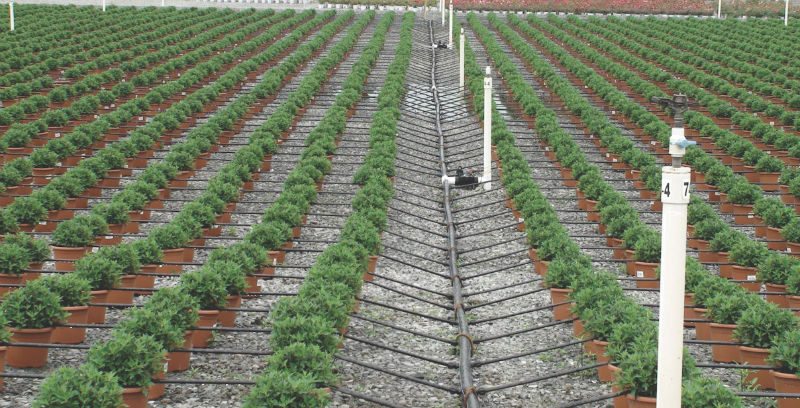
Implementing Efficient Irrigation
Irrigation inefficiency is one of the greatest challenges facing the horticultural and agricultural world in the 21st century. Inefficient irrigation results in stunted or drowned crops, incorrect application of fertilizer and potentially erosion and run-off.
There are a few options for efficient and sustainable irrigation in a greenhouse. Between drip irrigation, hydroponics and a combination of the two, these are some of the most innovative technologies in irrigation today.
Fertigiation and Drip Irrigation
Fertilizing plants at the right time with the correct intensity can have remarkable effects on crops. Applying fertilizer through an irrigation system is referred to as fertigation. Fertigation systems are often set up using drip tape irrigation. Combining precise fertilizer application with an efficient irrigation system creates a more direct path to the plant’s roots. This helps save growers when it comes to fertilizer input and wasted water, which are two concerns with traditional overhead watering and foliar spray fertilization.
Research shows that fertigation actually improves crop growth and quality, as well. The Department of Soil and Water Engineering, at Punjab Agricultural University, Ludhiana, conducted a two-year study to better understand the effects of irrigation and fertigation on greenhouse tomatoes. Applying the recommended nitrogen levels in an efficient drip fertigation system, resulted in an increase in fruit yield by approximately 60 percent in a greenhouse. This amount is nearly doubled in field production, because of the amount of water wasted in the field with traditional watering.
Even without implementing fertigation, drip irrigation alone can still save almost 50 percent of water use and create a 50 percent increase in fruit yield compared to traditional irrigation methods, like overhead sprinklers. In the same study, roots of crops in drip irrigation were lengthier compared to surface irrigated crop. Greenhouse tomato fruits were superior to fruits of open field crops in regard to fruit size, TSS content, ascorbic acid content and pH levels. Drip irrigation in greenhouses also resulted in significant improvement in all of the desired characteristics of crops.
With so many advantages, it is great to know that drip systems are generally affordable and easy to set up. Drip tape is often used in conjunction with hydroponics systems, but hydroponics, irrespective of drip tape use, reduces water waste to an even smaller fraction by recycling water through the system.

Hydroponics: The Future
Many experts today believe that hydroponics is the future for growing. While hydroponics is far from new, as far as growing methods go, hydroponics technology and efficiency is developing constantly to the point where we now have an array of hydroponics systems that are fully automated. So what kinds of benefits exist to growing hydroponically, and is it really the method of the future?
Hydroponics saves massive amounts of water by avoiding overhead watering. With overhead watering in traditional operations, most of the water is lost in the soil or on the soil surface on its way down to the plants’ roots. In a hydroponic system, water is recycled and reused, meaning less water waste in a global climate that has suffered from drought over recent years and will continue to do so. Hydroponics requires less than 10 percent of the water required to grow the same crop in the soil.
Accuracy in watering creates precision in a greenhouse system. Precision is a tenet of sustainability, which is highly considered in the development of greenhouse technologies. Using more precise methods and tools helps save resources and time. Hydroponics systems create a more precise application of water and nutrients. Not only are nutrients and fertilizers an expensive cost to a growing operation, they are also very commonly wasted with unsustainable application methods, including overhead spraying. In hydroponics systems, 60 percent less fertilizer needs to be applied. Many argue that the direct line of nutrients to the plants’ roots creates higher yields of larger, more flavorful and more nutritious produce, but benefits of hydroponics reach far outside of the greenhouse.
Hydroponics systems have a positive effect on their surrounding area. Hydroponics eliminates the use of soil and outdoor planting, which drastically minimizes erosion and leaching of contaminants into soil and ground water. Hydroponic systems don’t rely on the fields, which means this type of production causes little to no changes to the land and larger ecosystem. Even more importantly, hydroponics is not limited by acreage availability like traditional in-field agriculture.
In urban settings, there is a lack of traditional opportunities to grow food locally. Hydroponics maximizes greenhouse space and creates a more efficient growing operation. Particularly with the rise of urban farming, this quality of saving and maximizing space is one of the great innovations of hydroponics systems.
Advancements in hydroponics and congruently, automated technology, have synergized to make traditional farming a thing of the past. In a world that has begun to see the repercussions of conventional industrial farming, there is a growing concern in the global discussion regarding how to retrain ourselves to grow sustainably and healthfully. One of the best parts about greenhouse technology right now is the ability to find and implement a variety of levels of technology within an irrigation system. Automated greenhouse systems are gaining traction and seeing an essential future in the agricultural industry.
For all of these reasons, hydroponics and drip tape are two of the most sustainable growing methods available to farmers today. Every major industry is headed toward a worldwide trend of discovering the most sustainable methods to implement now, to help shape the future of their industries and our global environment.
Agriculture is the country’s largest industry, so it is vital to adapt and form more long-lasting solutions to food production.


 Video Library
Video Library 




















